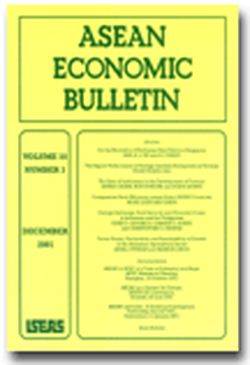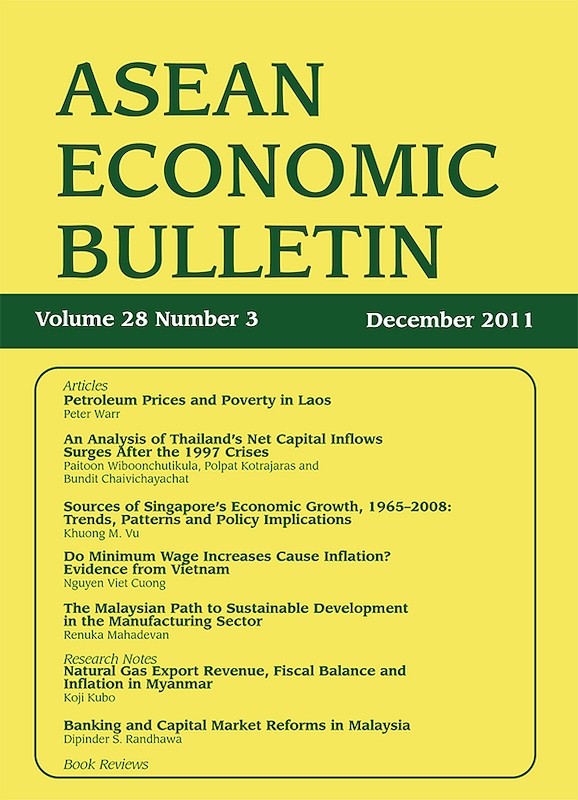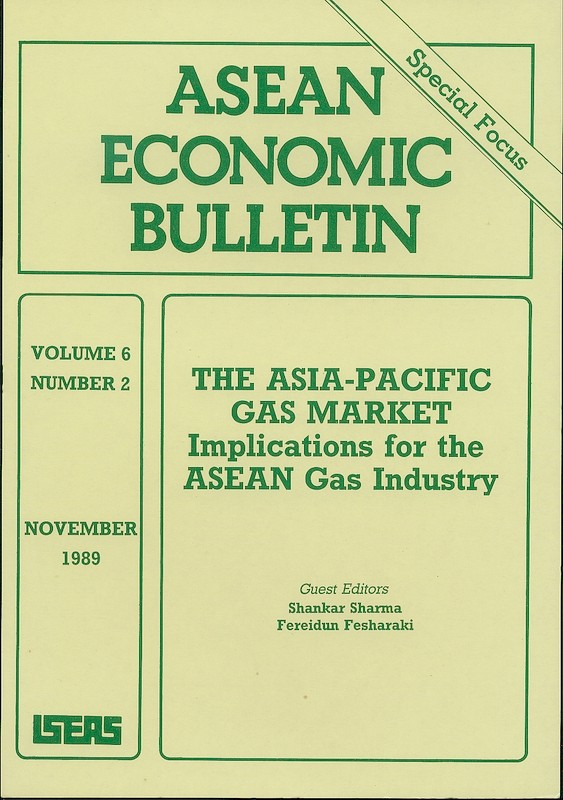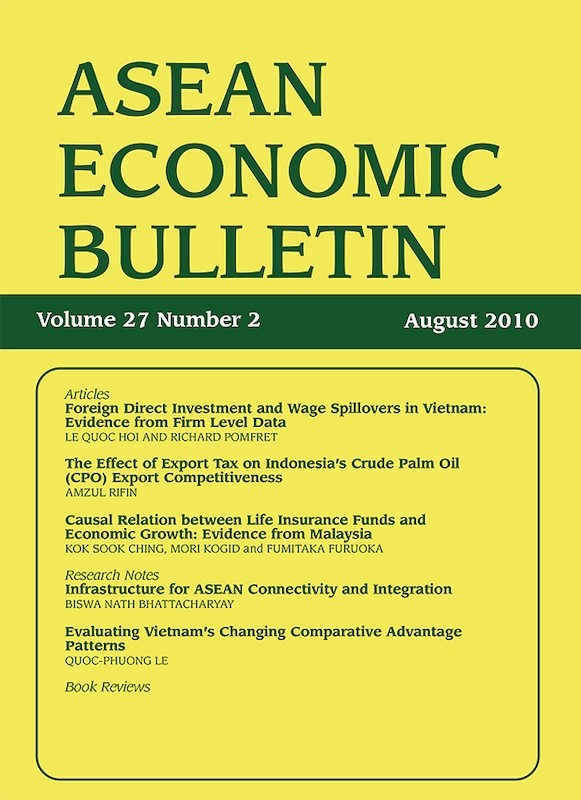Journal of Southeast Asian Economies Vol. 37/1 (April 2020)
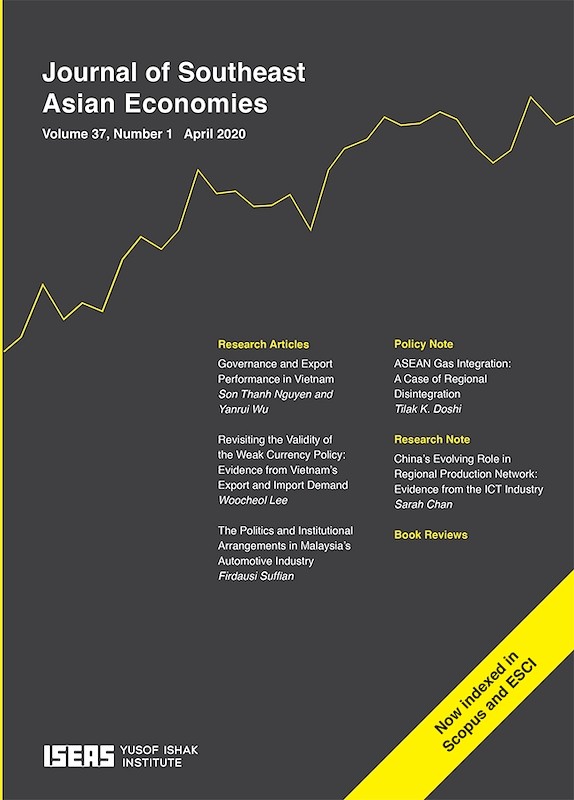
Date of publication:
April 2020
Publisher:
ISEAS – Yusof Ishak Institute
Number of pages:
99
Code:
AE37/1
About the publication
Contents
-
Journal of Southeast Asian Economies Vol. 37/1 (Apr 2020).
[Whole Publication, ISSN: 23395206] -
Preliminary page
- RESEARCH ARTICLES
-
1. Governance and Export Performance in Vietnam, by Son Thanh Nguyen, Yanrui Wu, authors see abstractSince <i>Doi Moi</i> in 1986, Vietnam has implemented a comprehensive economic renovation programme, including governance reform. As a result, the country has experienced impressive growth, mainly fuelled by rapid export expansion. This paper aims to examine the correlation between Vietnam’s export efficiency and bilateral-specific governance performance indicator during the 1996–2014 period. The results show that Vietnam’s export efficiency is positively correlated with the bilateral governance indicator and regional trade agreements, but negatively correlated with tariffs in the importing countries. The performance of Vietnam’s export efficiency also displays an overall increasing trend, with some fluctuation before 2005 and gradual rise afterwards. The country achieved high efficiency in terms of exports to all major trading partners—with the exception of China. At the disaggregated level, export efficiency in electronic equipment is very low, suggesting that there remains large unrealized export potential in this product category. Overall, these results indicate that there is plenty of room for Vietnam’s exports to grow in the future if the country can improve its efficiency in particular export products and/or markets.
-
2. Revisiting the Validity of the Weak Currency Policy: Evidence from Vietnam’s Export and Import Demand, by Lee Woocheol, author see abstractThis paper revisits the validity of the weak currency policy in Vietnam. It estimates the income and exchange rate elasticities of Vietnam’s bilateral export and import demand with its twenty-three trading partners between 1994 and 2016. The Fully Modified OLS (FMOLS) estimates suggest that the income elasticities of both export and import demand are consistently significant and more elastic with expected positive signs. Meanwhile, the exchange rate elasticities are inconsistent in terms of their size, sign and statistical significance. In general, bilateral import demand, compared to bilateral export demand, shows considerably inelastic exchange rate elasticity with signs that are opposite to expectation. Only three countries satisfy the Marshall-Lerner condition. Also, the influence of income over trade balance outweighs that of exchange rate. The weak currency policy that was once claimed to be effective is now ineffective in Vietnam as the country’s external sector is dominated by foreign-invested enterprises.
-
3. The Politics and Institutional Arrangements in Malaysia’s Automotive Industry, by Firdausi Suffian, author see abstractThis paper examines the strategic role of policymakers in shielding the interest of Malaysia’s domestic automotive producers. Policy arrangements formed by certain elites and national car makers have enabled coordination and mobilization of economic preferences in the latest version of the National Automotive Policy (NAP). Despite liberalization initiatives, the strategic role of policy actors in policy-making institutions has allowed some parties to tweak policy terms in favour of national car makers and local vendors. Although it may appear that the NAP is opening up the industry, actual pro-market reforms have been limited. This is inevitable due to the historical specificity and political considerations embedded in the country’s policy-making institutions.
- POLICY NOTE
-
4. ASEAN Gas Integration: A Case of Regional Disintegration, by Tilak K Doshi, author see abstractIn extant social science literature, there is a presumption that development is naturally associated with deepened regional economic integration. This, however, is an argument without foundation. In the case of natural gas in Southeast Asia, what has, in fact, occurred is a process of regional disintegration. Domestic supplies of natural gas in producing countries such as Myanmar, Malaysia and Indonesia are getting increasingly constrained, and pipeline supplies to neighbouring countries are expected to dwindle or cease altogether with supply contracts not being renewed. Grand visions of the Trans-ASEAN Gas Pipeline (TAGP), the region’s most ambitious mega project, have been made redundant by technological developments, market evolution and policy preferences among key regional governments. The concept of liquefied natural gas (LNG) trading hubs, which has received significant attention in recent years, faces equally challenging hurdles. Developments in the past few years have made it apparent that the option to directly import LNG has become a preferred option among ASEAN member countries.
- RESEARCH NOTE
-
China’s Evolving Role in Regional Production Networks: Evidence from the ICT Industry, by Sarah Chan, author see abstractChina’s accession to the WTO in 2001 and the subsequent liberalization of its FDI and trade policies have boosted the country’s exports and facilitated its improved participation in regional production networks. This paper builds on the existing literature on production networks by examining some of the recent structural changes in China’s intermediate goods trade with East Asia. Chinese policies to promote technological progress and indigenous innovation have been instrumental in bringing about such change, most of which can be captured by shifts or movements in the nation’s intra-industry trade index for intermediate goods. Two significant findings emerge from the empirical exercise: first, China is progressively reducing its reliance on import of intermediate goods for production and export; and second, the country remains integrated with East Asian economies in several technology-intensive sectors such as machinery and electronic devices.
- BOOK REVIEWS
-
BOOK REVIEW: Productivity and Innovation in SMEs: Creating Competitive Advantage in Singapore and South East Asia, by Azad Bali, Peter McKiernan, Christopher Vas and Peter Waring, by Toh Mun Heng, author
-
BOOK REVIEW: The Sustainable State: The Future of Government, Economy and Society, by Chandran Nair, by Serina Rahman, author
-
BOOK REVIEW: Beyond Debt: Islamic Experiments in Global Finance, by Daromir Rudnyckyj, by Nafis Alam, author
-
Thank You List

